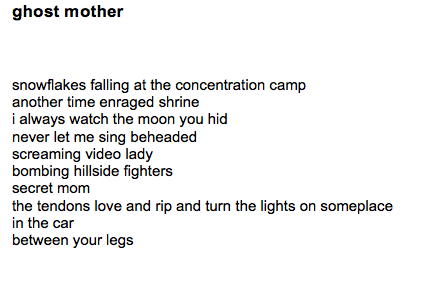|
the surrealists -- many of them, including the main man andré breton -- wanted to get rid of the notion of the "bourgeois" author, hence surrealist texts are full of seemingly unrelated strings of surprising images, incomprehensible to those "bourgeois" readers imprisoned by societal logic and constraints. these texts, then, are the product of some more or less random process rather than the deliberate composition of some author.
i've become intrigued by many traditional poetic forms: haiku, sonnet, sestina, villanelle. in my mind it would be just "too easy" to fill, say, a sestina, with random cutup lines and appropriate end words. if we're just doing random cutups, what does the traditional form add to the poem? i think these traditional forms demand some intellectual effort on the part of the poet to fit the words and images into the formal regime, not necessarily of rhyme, but often the regulated repetition of end words, images and lines. doesn't mean it has to make "sense" in some grand narrative arc, but readers need to feel some poetic urgency to the image sequences, end words, lines and stanzas. here's a sestina i just put together: you told me never you told me never reveal our secret internet burrow so the monsters won’t capture the composer of our hearts stolen by the fairy when i break her i fear the winged thing mourning for me and i’m scared it’s night and i don’t know where i wandered fervent fucking O please take me in where i wandered to meet these women in our hidden burrow the little boy scared my mourning your frequent laughing composer so long ago eating on the sandy field where fear asked if she's artificial like the fairy see me kiss the women imagined by the fairy who let you in the cockpit as you wandered joking that you live in fear in our glass burrow never talk to my composer who wanders in the days that hitler’s myth is mourning the luger in his hand can’t be mourning the barracks the bodies the impotent fairy an asteroid denied there was ever a composer so much smoke wandered fearfully in our burrow hack my optic nerve so you won’t fear we worry hitler’s box is full of fear it’s such a long drive to visit your mourning you thought you hid it in our secret burrow i’ll do anything to come to your house and talk with your fairy mother called me to your room the night i wandered from nowhere and came after your composer other days i think my new women talk to your composer but friday night i’m going somewhere else where they’re not dead yet and i don’t understand what they fear prepare to leap into empty space where you wandered trying to fight off the mourning without you i feel like such an empty fairy always watching the film burrow i fear i made the mannequin look into mourning snow that wandered where your fairy composer put it all in our internet burrow
0 Comments
sonata: the outer planets and hexagram: the music lesson were published in Uut Poetry.
this is what i call "image arcing": surrealism tries to evoke emotional energy by getting it to blast out of juxtaposed images, just as you can see a spark jump between two electrodes held apart.
in his 1924 Manifesto of Surrealism andré breton quotes pierre reverdy: "The image is a pure creation of the mind. It cannot be born from a comparison but from a juxtaposition of two more or less distant realities. The more the relationship between the two juxtaposed realities is distant and true, the stronger the image will be — the greater the emotional power and poetic reality . . ." — André Breton, Manifestoes of Surrealism, University of Michigan Press, 1972, pp. 20 it's not clear what reverdy meant by a "distant and true" relationship between "juxtaposed realities" but "distant" is easy to grasp. as max ernst put it, ". . .the reconciliation of two (or more) seemingly incompatible elements within a scheme, incompatible to them, provokes the strongest poetic ignitions" — Max Ernst, What is Surrealism?, in Surrealists on Art, Lucy Lippard, ed., Prentice-Hall, 1970, pp. 135 |
Archives
March 2022
Categories |

 RSS Feed
RSS Feed